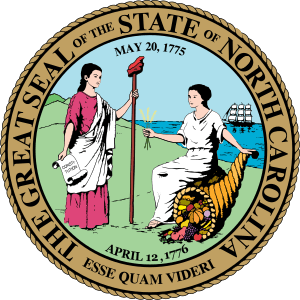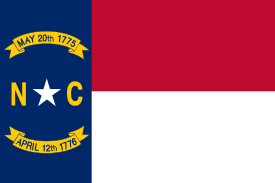Tryon, North Carolina
Tryon is a town in Polk County, North Carolina, United States. As of the 2010 census, the city population was 1,646.[2] Located in the escarpment of the Blue Ridge Mountains, the affluent area[6] is a center for outdoor pursuits, equestrian activity and fine arts.
Tryon, North Carolina | |
|---|---|
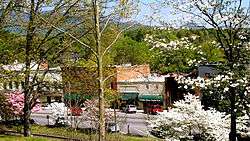 Trade Street, Tryon, North Carolina | |
| Motto(s): "The Friendliest Town In The South" | |
Location of Tryon, North Carolina | |
| Coordinates: 35°12′32″N 82°14′20″W | |
| Country | United States |
| state | North Carolina |
| county | Polk |
| Named for | William Tryon |
| Area | |
| • Total | 2.00 sq mi (5.17 km2) |
| • Land | 2.00 sq mi (5.17 km2) |
| • Water | 0.00 sq mi (0.00 km2) |
| Elevation | 1,102 ft (336 m) |
| Population | |
| • Total | 1,646 |
| • Estimate (2019)[3] | 1,615 |
| • Density | 808.71/sq mi (312.19/km2) |
| Time zone | UTC-5 (Eastern (EST)) |
| • Summer (DST) | UTC-4 (EDT) |
| ZIP code | 28782 |
| Area code(s) | 828 |
| FIPS code | 37-68580[4] |
| GNIS feature ID | 0996284[5] |
| Website | tryon-nc.com |
Tryon Peak and the Town of Tryon are named for William Tryon, Governor of North Carolina from 1765 to 1771 in recognition of his negotiation with the Cherokee for a treaty during a bloody period of conflict during the French and Indian War.
History
Cherokee
The area which Tryon now occupies was originally part of the Cherokee hunting grounds[7] of Western North Carolina. Archaeological evidence dates indigenous peoples' occupation of the site to the end of the last Ice Age, more than 11,000 years ago. Semi-permanent villages appeared in the area by about 8,000 B.C. They later settled in towns with a democratic political structure, religion, domesticated crops, pottery and skilled, powerful archery, and survived through growth of vegetables, hunting and fishing. Each Cherokee village had a peace chief, war chief, and priest.[8]
De Soto

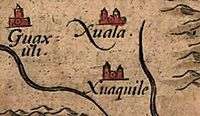
Having landed near present-day Panama City, Florida on May 30, 1539,[9] Spanish explorer Hernando de Soto reputedly traveled up to what is now Spartanburg, South Carolina and north to western North Carolina.[10] Traveling on horses, de Soto and 1,000 men arrived in North Carolina in mid-May, 1540.[11] In search of gold, de Soto explored the Asheville area and met with Cherokee Indians in Xuala, the area now known as Tryon. After a day or two, de Soto continued his journey with provisions provided by the Cherokee.[10]
Luys Hernandez de Biedma, one of de Soto's officers, wrote of a group of men who made their way to what is now Tryon on May 21, 1540:
The next day, they went to Xuala which is a town on a plain between some rivers; its chief was so well provisioned that he gave to the Christians however much they asked for: slaves, corn, little dogs [probably opossums]… and however much he had.
After Tryon, de Soto went to Gauxuile (now Asheville) which in Cherokee meant "The place where they race," named for the walk around the perimeter of the village.
Early English settlement
In the earliest periods of settlement, the British and Cherokee enjoyed peaceful relations. A treaty signed in 1730 resulted in a greater influx of white traders and settlers.[7] An early home, Seven Hearths was built in 1740, and is reputedly the oldest clapboard house in the county, which was moved to its present location in 1934. A log cabin that served as slave quarters was also built about 1740 and moved and rebuilt next to Seven Hearths.[13]
The French and Indian War forever ended the peace that existed between the Cherokee and the English settlers, bringing to an end a relatively peaceful period.[7] The French, who were allied with the Creeks, attempted to ally themselves with the Cherokee (who had been loyal to the British), and encouraged the Shawnees to raid settlements of the English. As conflict and tension increased, defensive forts were constructed, one of which was the "Block House" near Tryon.[14] In 1767 William Tryon, governor of the North Carolina Colony from 1765 to 1771), traveled to the area and negotiated a peace treaty with the Cherokee, establishing a boundary line between a location near Greenville, South Carolina the highest point on White Oak Mountain (renamed Tryon Peak by the settlers). Settlers, though, did not commit to the boundary and tension grew with the outbreak of the Revolutionary War. In the spring of 1776 Cherokee met on Round Mountain and planned an attack on the "Block House", Earl's Fort in Landrum, South Carolina and Young's Fort near the current town of Mill Spring, North Carolina. Aware of the plans, a Cherokee named Skyuka went to the "Block House" where he warned his friend Capt. Thomas Howard of the impending attacks. Howard and the assembled local militia took a trail toward Round Mountain where they met and defeated the Cherokee at a gap in the valley, now known as Howard Gap.[14] Skyuka's name lives on in Skyuka Creek, Skyuka Road, and the YMCA Camp Skyuka on Mount Tryon.[15]
The town's beginnings
In 1839 a post office was established at the base of Tryon peak, both named after Governor Tryon.[7] By 1877 the railroad provided transportation from the South Carolina seaports to North Carolina, Tennessee, and the Ohio Valley.[16] The particular spot that became the town of Tryon was the point where construction of the railroad to Asheville stopped for two years. West of Tryon, the railroad ascends the Blue Ridge along the Saluda Grade, which was the steepest railroad grade in the country before becoming inactive. At the peak of railroad expansion in 1885, Tryon was incorporated.[17] By the 1890s, there were six daily railway stops in Tryon.[16] The current depot building, built in 1922, is the third depot built. Passenger service to Tryon ended in 1968.[16]
As a means of correction, in 1920 Tryon became a town instead of a city since it had less than 10,000 residents.[18]
Oak Hall Hotel
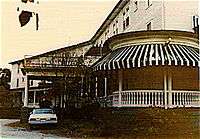
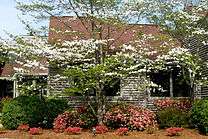
In 1881 and 1882 T.T. Ballenger and his father-in-law built the Tryon Hotel at 77 Chestnut Street at Melrose. In 1892 Mrs. Delia Williams purchased the hotel, changed its name to Oak Hall and ran it for three years. "Miss Clara" Edwards purchased the hotel with 36 rooms and expanded it to 66. Oak Hall had notable guests, such as David Niven, F. Scott Fitzgerald, George Gershwin, Mrs. Calvin Coolidge, Lady Nancy Astor, and Mrs. George C. Marshall. In October 1979, too cost prohibitive to maintain, the building was torn down.[16] It is now a condominium complex sitting on a bluff that looks over Trade Street.[19]
Appreciative of the ice cream served at Misseldine's drug store (previously located at the current bank location on Trade Street), F. Scott Fitzgerald wrote,[20]
Oh Misseldine's, dear Misseldine's,
A dive we'll ne'er forget,
The taste of its banana splits
Is on our tonsils yet.
Its chocolate fudge makes livers budge,
It's really too divine,
And as we reel, we'll give one squeal
For dear old Misseldine's.
Geography
The elevation is 1,067 feet (325 m) above sea level. The town's original boundary was established as a circle with a radius of three quarters of a mile.[18] According to the United States Census Bureau, the town has a total area of 1.8 square miles (4.7 km2), all of it land.
Climate
Tryon is located near a "thermal belt", an area generally free of dew and frost that provides an enjoyable climate year-round.[21] It was the initial draw of many of Tryon's visitors and residents. In this region of the Blue Ridge mountains, air may be warmer on the slopes than the base of a valley,[22] particularly in the spring and fall, causing longer periods of warm weather throughout the year and greater crop yields.[7]
However, data indicate that Tryon has a similar climate to comparable areas of the Piedmont.
| Climate data for Tryon, North Carolina (1917–2010) | |||||||||||||
|---|---|---|---|---|---|---|---|---|---|---|---|---|---|
| Month | Jan | Feb | Mar | Apr | May | Jun | Jul | Aug | Sep | Oct | Nov | Dec | Year |
| Record high °F (°C) | 83 (28) |
82 (28) |
92 (33) |
94 (34) |
98 (37) |
105 (41) |
104 (40) |
103 (39) |
103 (39) |
96 (36) |
87 (31) |
82 (28) |
105 (41) |
| Average high °F (°C) | 53.4 (11.9) |
56.6 (13.7) |
64.5 (18.1) |
73.6 (23.1) |
80.1 (26.7) |
86.2 (30.1) |
88.4 (31.3) |
87.3 (30.7) |
82.0 (27.8) |
73.3 (22.9) |
63.4 (17.4) |
54.7 (12.6) |
72.0 (22.2) |
| Average low °F (°C) | 31.5 (−0.3) |
33.0 (0.6) |
38.9 (3.8) |
46.4 (8.0) |
54.5 (12.5) |
62.3 (16.8) |
66.1 (18.9) |
65.2 (18.4) |
59.6 (15.3) |
48.3 (9.1) |
39.5 (4.2) |
33.0 (0.6) |
48.2 (9.0) |
| Record low °F (°C) | −8 (−22) |
4 (−16) |
11 (−12) |
23 (−5) |
30 (−1) |
40 (4) |
44 (7) |
47 (8) |
35 (2) |
25 (−4) |
8 (−13) |
0 (−18) |
−8 (−22) |
| Average precipitation inches (mm) | 5.23 (133) |
5.11 (130) |
6.19 (157) |
4.77 (121) |
5.02 (128) |
5.19 (132) |
5.52 (140) |
5.99 (152) |
5.14 (131) |
4.62 (117) |
4.27 (108) |
5.35 (136) |
62.4 (1,580) |
| Average snowfall inches (cm) | 2.4 (6.1) |
1.6 (4.1) |
1.2 (3.0) |
0 (0) |
0 (0) |
0 (0) |
0 (0) |
0 (0) |
0 (0) |
0 (0) |
0 (0) |
1.2 (3.0) |
6.4 (16) |
| Source: SERCC,[23] NOAA[24] | |||||||||||||
Demographics
| Historical population | |||
|---|---|---|---|
| Census | Pop. | %± | |
| 1900 | 324 | — | |
| 1910 | 700 | 116.0% | |
| 1920 | 1,067 | 52.4% | |
| 1930 | 1,670 | 56.5% | |
| 1940 | 2,043 | 22.3% | |
| 1950 | 1,985 | −2.8% | |
| 1960 | 2,223 | 12.0% | |
| 1970 | 1,951 | −12.2% | |
| 1980 | 1,796 | −7.9% | |
| 1990 | 1,680 | −6.5% | |
| 2000 | 1,760 | 4.8% | |
| 2010 | 1,646 | −6.5% | |
| Est. 2019 | 1,615 | [3] | −1.9% |
| U.S. Decennial Census[25] | |||
As of the census[4] of 2000, there were 1,760 people, 869 households, and 452 families residing in the town. The population density was 955.0 people per square mile (369.3/km2). There were 985 housing units at an average density of 534.5 per square mile (206.7/km2). The racial makeup of the town was 77.16% White, 21.02% African American, 0.28% Native American, 0.11% Asian, 0.68% from other races, and 0.74% from two or more races. Hispanic or Latino of any race were 1.25% of the population.
There were 869 households out of which 16.3% had children under the age of 18 living with them, 39.8% were married couples living together, 10.1% had a female householder with no husband present, and 47.9% were non-families. 44.8% of all households were made up of individuals and 28.8% had someone living alone who was 65 years of age or older. The average household size was 1.92 and the average family size was 2.66.
In the town, the population was spread out with 16.7% under the age of 18, 4.2% from 18 to 24, 19.6% from 25 to 44, 21.8% from 45 to 64, and 37.7% who were 65 years of age or older. The median age was 52 years. For every 100 females, there were 72.7 males. For every 100 females age 18 and over, there were 68.9 males.
The median income for a household in the town was $31,449, and the median income for a family was $44,485. Males had a median income of $35,956 versus $23,333 for females. The per capita income for the town was $21,347. About 7.9% of families and 14.3% of the population were below the poverty line, including 23.2% of those under age 18 and 9.4% of those age 65 or over.
More than half of Tryon's full-time residents are "transplants" from other areas of the country, some of whom have helped to create the cultural center that continues to attract other writers, educators, artists, and professional people to the Tryon area.[7]
Religion
Tryon's churches include: Grace Foothills Church (PCA) which meets in the historic Tryon Theatre, Tryon Presbyterian Church (PCUSA), Holy Cross Church & Chapel (Episcopal), Congregational Church, St. John the Baptist Catholic Church, First Baptist Church, Trinity Lutheran Church LCMS.[16] Other churches include Garrison Chapel Baptist Church. The Good Shepherd Episcopal Church, originally a slave chapel known as St. Andrews on the Coxe Plantation, was moved to Tryon in 1955. Located on Jackson Road, it still has original furnishings and glass.[13][26]
Economy
Agriculture
The southern exposure of Tryon's hills provides a conducive environment for orchards and vineyards. Vineyards were established in the Pacolet Valley, on Old Howard Gap, and other Tryon locations.[22] By the 1950s the industry suffered due to decline in railroad transportation and competition with Californian grapes. However, viticulture is beginning to make a comeback in the area; since the 1990s, several vineyards have been established in and around Tryon.[16]
Tourism
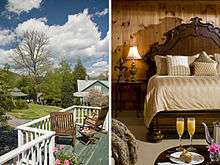
Tryon has a long history as a tourism destination, particularly as a retreat location for writers and artists.[27] The Pine Crest Inn was originally built in 1906 as a sanitarium for those with tuberculosis. In 1917 it was converted to an inn.[28] The inn was placed on the National Register of Historic Places in 1982. Its dining room has a AAA four diamond designation. Early in the inn's history hunters were attracted by its location, sitting right on the edge of the wilderness. Swayback cabin, now more than 240 years old, has hosted both Ernest Hemingway and F. Scott Fitzgerald.[29]
Tryon has also long been a center of equestrian-related tourism. Over the years, Tryon has served as a training location for the U.S. Olympic Equestrian team. In 2018, Tryon played host to the FEI World Equestrian Games, the “Horse Olympics,” which drew hundreds of thousands of visitors to the area.
Culture
Arts
- The Tryon Fine Arts Center
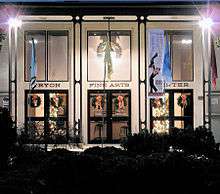
The Tryon Fine Arts Center located on Melrose Avenue, is a visual and performing arts center that offers music, drama, film and other cultural programs. Founded in 1969, the non-profit organization offers a number of classes in the arts. The center's theater seats 345 individuals and has a system for the hearing impaired.[30][31] Located, exhibiting, or performing within the center are: the Tryon Painters and Sculptors[32] and the Carolina Photo Club. The Photo Club annually exhibits in January and February. The group, affiliated with the Photographic Society of America, meets monthly and conducts an annual contest where winning submissions are exhibited in the Tryon Fine Arts Center.[33]
- Tryon Arts and Crafts School

Established in 1960, Tryon Arts and Crafts School provides the community with creative opportunities "through education, instruction, and expression of heritage and contemporary arts and crafts" created and showcased at the school. In the 1950s local artists offered space in their homes for fine arts and crafts. The blizzard of 1959 was the impetus for creation of a formal organization. Grace Hall, a local resident who had been trapped in her home for three weeks, wrote to the Tryon Daily Bulletin with an idea: form a local crafts center so that area residents would have the knowledge to create arts or crafts so that in the wake of another blizzard they would have something to do with their time. Many agreed, including architect Carter Brown and Tryon philanthropist Violet Parish-Watson. In April 1960, 200 area residents pledged a one-dollar membership fee to support what would be called Tryon Crafts, Inc. "Recapturing Tryon's history as an artist's colony," local artisans began selling work and teaching classes. After residing in several locations, Tryon Arts & Crafts (named since 2004) is located at 373 Harmon Field Road, adjacent to Harmon Field. The facility offers professional studios for a wide variety of arts, such as fiber arts, pottery, jewelry, lapidary, woodworking, multimedia and blacksmithing.[34]
- Tryon Concert Association
The Tryon Concert Association claims to have been bringing "world-class artists" to Tryon since the first concert in January 1955 when baritone Robert McFerrin gave a recital. Soon after the performance McFerrin was the first African-American to join the Metropolitan Opera Company. The Tryon Concert Association provides a series of four concerts from the fall through spring with talent that rivals that of large metropolitan cities.[35]
- Tryon Little Theater
The Tryon Little Theatre holds classes and workshops at the Tryon Little Theater Workshop on Highway 176. Season performances by this organization can also be seen at the Tryon Fine Arts Center in Tryon.[36]
- Tryon Youth Center
Tryon Youth Center, located in a 5,300-square-foot (490 m2) building on US Highway 176, offers artistic, social and recreational programs for the young people of the local area. Annually a Youth Center Summer Musical production is held at the Tryon Fine Arts Center.[37]
- Children's Theatre Festival
Children's Theater Festival organized in 1978 offers "lively arts" for children including: "Eight to ten different performances, encompassing theater, music, storytelling, mime, dance, puppetry, and more are brought to Tryon on a Saturday in late March."[38]
- Nina Simone Birthplace
Tryon is the birthplace of singer and piano player Nina Simone, whose childhood home was saved by four African-American artists: Adam Pendleton, Ellen Gallagher, Rashid Johnson, and Julie Mehretu who jointly bought the property. The home has been named a national treasure by the National Trust for Historic Preservation.
Equestrian community
Local historian and former Tryon Riding and Hunt Club President Colonel Charles C. Ross, U.S. Army (Retd.) said at a Polk County Historical Association meeting in April 2010, "The horse is all important in Polk County. Horses provide sport, pleasure, entertainment, business, and the good country living. It can be said that horses are a way of life in our pleasant community here in rural North Carolina." Much of that started with Carter Brown who came to Tryon from Michigan in 1917 and opened the Pine Crest Inn, a place where moneyed northerners could enjoy riding horses or play golf during the winter months. In 1925 Brown founded and was the first president of the Tryon Riding and Hunt Club. With Brown's inspiration, the Tryon Horse Show and the Block House Steeplechase were born in 1929 and 1934, respectively. The Tryon Horse Show "was so popular that the schools were let out and most businesses closed for the afternoon," Ross said. In 1956, the US Equestrian Team prepared and trained for the 1956 Olympics in Tryon. The Tryon Horse Show remains today as the third oldest horse show and a rated United States Equestrian Federation event, and smaller shows are held at Harmon Field and the Tryon Horse Shows are at the Foothills Equestrian Nature Center (FENCE). Many local organizations such as the Carolina Carriage Club, the Blue Ridge Hunter Jumper Association, Foothills Riding Club, and River Valley Pony Club hold shows and events.[39]
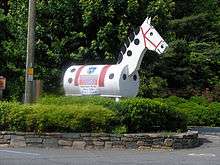
Morris, the Tryon Horse, stands at the center of Tryon. The Tryon horse, a large version of toys made by the Tryon Toymakers and Woodcarvers, was first built in 1928 for the Tryon Riding and Hunt Club. The current Morris is the fifth generation, three of the previous versions succumbed to fire, mischievous kidnapping and age and the fourth was refurbished with a fiberglass body. Morris serves as a billboard during the Tryon Horse Show and Block House Steeplechase Races. At Christmas, he is decorated with garland and a top hat.[15]
In May 2012, a group of Tryonite volunteers, in conjunction with the Town of Tryon and the Tryon Daily Bulletin (The World's Smallest Daily Newspaper!), banded together to raise money for the restoration and maintenance of the badly deteriorating Morris. The enormous statue was "kidnapped" in the dead of night on June 8, 2012, and held for "ransom". The refurbished Morris was returned to his rightful spot in November, 2012.
- Tryon International Equestrian Center (TIEC)
In June 2014, the $100 million TIEC and Resort opened to host numerous multi-day, international-level equestrian competitions across several disciplines in collaboration with the Tryon Riding and Hunt Club. Located just outside Tryon in Mill Spring, the 1400-acre equestrian facility features up to 10 riding arenas (including one with stadium seating for 6,000), 1,000 permanent stalls, elevated and shaded viewing decks, a large covered riding facility and the Tryon Sports Complex, which includes a health club, game room, kids' camp, sports bar, children's playground, tennis courts, mountain bike park, climbing walls, basketball court, and a large pool. A 150-room hotel overlooks the equestrian center.[40] The TIEC hosted the 2018 World Equestrian Games.[41][42]
- Foothills Equestrian Nature Center
The Foothills Equestrian Nature Center (FENCE) is a 380-acre (1.5 km2) nature preserve of trails for hiking, riding and bird-watching. The center, which also includes picnic areas and a pond, hosts equestrian events and concerts.[21][43]
Library
The Lanier Library Association is named for poet Sidney Lanier,[44] who died September 7, 1881 in "the Wilcox home" on Highway 108 in Lynn, three miles (5 km) north of Tryon, which since has been known as the Lanier House.[13] The idea for a library was developed in 1889 by five women from Tryon with the goal of being "the source of intellectual and cultural stimulation for the community", achieved through library membership to local women. Two volumes of Sidney Lanier's poems, a gift from his wife Mary were the first books for the library. Initially the library was a bookcase of books located in several places in town before being formally located in the Lanier Library building built in 1905 and expanded over the years. In 1930 the library established an endowment fund to support the library and extended library membership to include men. The Lanier Library Association, Inc., previously called the Lanier club, was organized to provide library services and related cultural programs to the community. Lanier Library remains a membership library supported solely by membership dues, endowments and donations, one of only a few membership libraries in the country.[45]
Recreation
The area is known for its scenic drives of tailored horse farms, hardwood forests, and kudzu landscaped scenery of the Carolina foothills.[21]
Parks
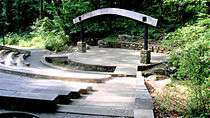


Tryon has a number of parks including:
- Rogers Park located in downtown Tryon is a park and an open-air amphitheatre. The natural setting includes a small creek and trails and also landscaping with native plants and Crab Orchard stone walls. Its facilities are used for public events, such as music performances, and can be reserved for private events, such as weddings and other occasions.[46]
- Greene Corner, on Melrose Avenue across from the entrance to the Tryon Fine Arts Center, is a beautiful garden and gazebo often used for wedding photos. The Sassoon Park, also on Melrose Avenue, has a modern sculpture and greenery.[13]
- Harmon Field, a 46-acre (190,000 m2) park in Tryon located on Harmon Field Road between US Hwy 176 and NC Hwy 108, is regularly used by town residents and visitors. It offers a variety of activities, from relaxing on trails to active sports participation:[47]
- For horse-back riders there periodic events (see their calendar of events) and facilities include four horse rings and 140 stalls.
- For the sports-minded there are three baseball fields, two soccer fields, four tennis courts, basketball courts, putting green, disc golf course, and a playground.
- For those inclined for a leisurely walk there are trails and a community garden.
- Shelters and grills are available for picnics.
- The field also offers rental facilities and a concession stand.
- The Blue Ridge Barbecue and Music Festival, "One of America's most prestigious barbecue competitions!", is held annually at Harmon Field.[48]
Scenic areas and drives
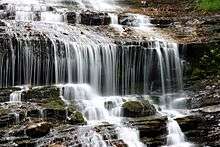
- Pacolet Scenic Byway, one of North Carolina Scenic Byways, is a ten-mile (16 km) portion of US 176 that runs from Tryon to Saluda. The scenic drive provides scenic views of the Pacolet River and waterfalls.[49]
- Pearson's Falls Natural Heritage Site, named for its 90-foot (27 m) waterfall, is owned and maintained by the Tryon Garden Club. Located between Tryon and Saluda, it is offers a picnic area and hiking and biking trails for its customers.[49] There is a one-quarter mile walk to the waterfall off from US 176. The "botanical preserve" offers more than 200 species of wildflowers and plans and has been classified as a deciduous climax forest. An engineer, Charles William Pearson, scouted the Blue Ridge Mountains for the Southern Railroad and it's his name that labels the waterfalls.[50]
Tryon in the media
Margaret Culkin Banning's novel I Took My Love to the Country features the town "DeSoto", known to be Tryon, which attracted visitors for its climate, performing arts and equestrian events.[51]
Transportation
Tryon is located west of Interstate 26 that runs northwest to Asheville and southeast to Spartanburg, South Carolina approximately one mile from the NC/SC border. U.S. Highway 176 runs through the center of town where it is known as Trade Street.[52]
Notable people
- George Charles Aid (1872 – 1938), American painter[53]
- Katharine Alexander (1898 - 1981), actress, died in Tryon
- Margaret Culkin Banning, whose home "Friendly Hills", was listed on the National Register of Historic Places in 1998.[28][54]
- Cathy Smith Bowers, poet and professor; North Carolina Poet Laureate, 2010–2012
- William Gillette, actor who built a home in Tryon, later home to the Thousand Pine Inn.[55]
- Richard Christian Nelson, artist
- Nina Simone, singer, pianist, composer, and activist[16]
- Henry Jacques Garrigues, Danish-born doctor considered to have introduced antiseptic obstetrics to the United States
- Crystal R. Fox, actress. Best known for playing Luanne Corbin on In the Heat of the Night; and playing Hanna Young in Tyler Perry’s show The Haves and the Have Nots.
- Mary Alice Monroe, author
References
- "2019 U.S. Gazetteer Files". United States Census Bureau. Retrieved July 27, 2020.
- "2010 City Population and Housing Occupancy Status". U.S. Census Bureau. Retrieved August 18, 2012.
- "Population and Housing Unit Estimates". United States Census Bureau. May 24, 2020. Retrieved May 27, 2020.
- "U.S. Census website". United States Census Bureau. Retrieved 2008-01-31.
- "US Board on Geographic Names". United States Geological Survey. 2007-10-25. Retrieved 2008-01-31.
- https://www.zipdatamaps.com/28782
- Richards, C.; Richards, L (2008) [2002]. Insiders' Guide to North Carolina's Mountains: Including Asheville, Biltmore Estate, Cherokee, and the Blue Ridge Parkway. Guilford, Connecticut: The Globe Pequot Press. p. 14.
- "History". Cherokee, North Carolina. 2010. Retrieved 2011-05-01.
- Jones Helsley, A; Jones, G (2007). A Guide to Historic Henderson County, North Carolina. Charleston, SC: The History Press. p. 17. ISBN 978-1-59629-275-8.
- "Cherokee Native American Indian History: 1500s". ashevillelist.com. 2000–2011. Retrieved 2011-05-02" Reference: Ho, Cynthia, Sawin, Sheryl, Spellman, W.M., The Asheville Reader: The Medieval and Renaissance World, Pegasus Press, Asheville, NC, 1998. pgs.395 -396.
- Cannavale, M; Griffin, P (2007). Voices from Colonial America: North Carolina 1524-1776. Washington, D.C.: National Geographic Society. p. 21. ISBN 978-1-4263-0032-5.
- "Historic Places". polkcounty.org. Archived from the original on 2011-07-18. Retrieved 2011. Check date values in:
|accessdate=(help) - Rozema, V (2007) [1995]. Footsteps of the Cherokees: A Guide to the Eastern Homelands of the Cherokee Nation. John F. Blair. p. 257. ISBN 0-89587-346-X.
- "A Short History of Tryon". PolkCounty.org. 2011. Archived from the original on 2010-12-21. Retrieved 2011. Check date values in:
|accessdate=(help) - Gloria Underwood (research) (2010). "Historic Tryon Walking Tour". Tryon. Tryon Downtown Development Association. Archived from the original on 2011-02-13. Retrieved 2011-05-01.
- "Welcome". Tryon Visitors Information. Retrieved 2011-05-01.
- "History". Tryon Visitors Information. Archived from the original on 2013-01-24. Retrieved 2011-05-01" Content courtesy of polkcounty.org
- Eubanks, G (2008). Literary Trails of the North Carolina Mountains. 2. Accessible Reading Publications. p. 108.
- Eubanks, G (2008). Literary Trails of the North Carolina Mountains. 2. Accessible Reading Publications. p. 111.
- Lawson Wallace, J (2003). Road Biking North Carolina. Guilford, Connecticut: The Globe Pequot Press. pp. 191–192.
- "Thermal Belts in North Carolina". Isothermal Community College. Archived from the original on 2011-04-29. Retrieved 2011-05-01" Source: W. B. No. 796, U.S. Department of Agriculture Weather Bureau, MONTHLY WEATHER REVIEW SUPPLEMENT NO. 19., "Thermal Belts and Fruit Growing in North Carolina" and "Thermal Belts from the Horticultural Viewpoint," Government Printing Office, Washington, D.C.
- "Historical Climate Summary for Tryon, North Carolina (1917-2010)". The Southeast Regional Climate Center. May 2011. Retrieved 2011-06-12.
- "Surface Data, Monthly Extremes, Tryon, N.C. (1931-2009)". National Oceanic and Atmospheric Administration. Retrieved 2010-07-13.
- "Census of Population and Housing". Census.gov. Retrieved June 4, 2015.
- "About Us (Our history)". Good Shepherd Episcopal Church. Archived from the original on 2015-02-12. Retrieved 2011. Check date values in:
|accessdate=(help) - "Polk County Tourism: Saluda, Tryon and Columbus". Retrieved 2011-05-09.
- "Mill Farm Inn Earns Register Listing". The Historic Preservation Foundation of North Carolina, Inc. 2011. Archived from the original on 2012-03-12. Retrieved 2011. Check date values in:
|accessdate=(help) - Eubanks, G (2008). Literary Trails of the North Carolina Mountains. 2. Accessible Reading Publications. p. 117.
- "Tryon Fine Arts Center". Archived from the original on 2011-08-08. Retrieved 2011-05-01.
- Richards, C.; Richards, L (2008) [2002]. Insiders' Guide to North Carolina's Mountains: Including Asheville, Biltmore Estate, Cherokee, and the Blue Ridge Parkway. Guilford, Connecticut: The Globe Pequot Press. pp. 329–330.
- "Tryon Painters and Sculptors". Tryon Fine Arts Center. Archived from the original on 2011-03-14. Retrieved 2011-05-01.
- Richards, C.; Richards, L (2008) [2002]. Insiders' Guide to North Carolina's Mountains: Including Asheville, Biltmore Estate, Cherokee, and the Blue Ridge Parkway. Guilford, Connecticut: The Globe Pequot Press. p. 329.
- "Tryon Arts and Crafts School". Tryon Arts & Crafts, Inc. 2007. Archived from the original on 2013-12-10. Retrieved 2011. Check date values in:
|accessdate=(help) - "Tryon Concert Association". Tryon Fine Arts Center. Archived from the original on 2011-08-31. Retrieved 2011-05-01" Also see "History"
- "Tryon Little Theatre". Retrieved 2011-05-01.
- Richards, C.; Richards, L (2008) [2002]. Insiders' Guide to North Carolina's Mountains: Including Asheville, Biltmore Estate, Cherokee, and the Blue Ridge Parkway. Guilford, Connecticut: The Globe Pequot Press. p. 330.
- "Children's Theater Festival". Tryon Fine Arts Center. Archived from the original on 2011-03-14. Retrieved 2011-05-01.
- "Block House Founder, Carter Brown, 'Put Tryon on the Map'". Tryon Daily Bulletin. April 16, 2010. Retrieved 2011-05-01.
- http://www.citizen-times.com/story/news/local/2014/06/25/m-equestrian-center-unveiled-polk-county/11351925/?from=global&sessionKey=&autologin=
- "North Carolina to Host 2018 FEI World Equestrian Games". TheHorse.com. 3 November 2016. Retrieved 3 November 2016.
- https://www.goupstate.com/news/20180921/mark-bellissimo-upbeat-optimistic-about-future-as-world-equestrian-games-wind-down
- "Foothills Equestrian Nature Center". Foothills Equestrian Nature Center. 2011. Retrieved 2011-05-01.
- Federal Writers' Project (N.C.) (1939). North Carolina: A Guide to the Old North State. Chapel Hill: The University of North Carolina Press. p. 470.
- "History". Lanier Library. Lanier Library Association. Archived from the original on 2011-06-10. Retrieved 2011-05-02.
- "Roger's Park". Tryon. Tryon Downtown Development Association. 2010. Archived from the original on 2013-09-02. Retrieved 2011. Check date values in:
|accessdate=(help) - "Harmon Field Park & Recreation". the Town of Tryon and Harmon Field Board of Supervisors. Retrieved 2011. Check date values in:
|accessdate=(help) - "Blue Ridge Barbecue & Music Festival". Blue Ridge Barbecue Festival. 2011. Retrieved 2011-05-02.
- Lawson Wallace, J (2003). Road Biking North Carolina. Guilford, Connecticut: The Globe Pequot Press. p. 196.
- "Pearson's Falls". The Tryon Garden Club. Retrieved 2011-05-01.
- Eubanks, G (2008). Literary Trails of the North Carolina Mountains. 2. Accessible Reading Publications. p. 100.
- Eubanks, G (2008). Literary Trails of the North Carolina Mountains. 2. Accessible Reading Publications. p. 106.
- Ashevilleart.org
- "National Register of Historic Places". National Park Service. 2011. Retrieved 2011" Advanced search: "Friendly Hills" in Polk County, North Carolina Check date values in:
|accessdate=(help) - Eubanks, G (2008). Literary Trails of the North Carolina Mountains. 2. Accessible Reading Publications. p. 111.
External links
| Wikimedia Commons has media related to Tryon, North Carolina. |
